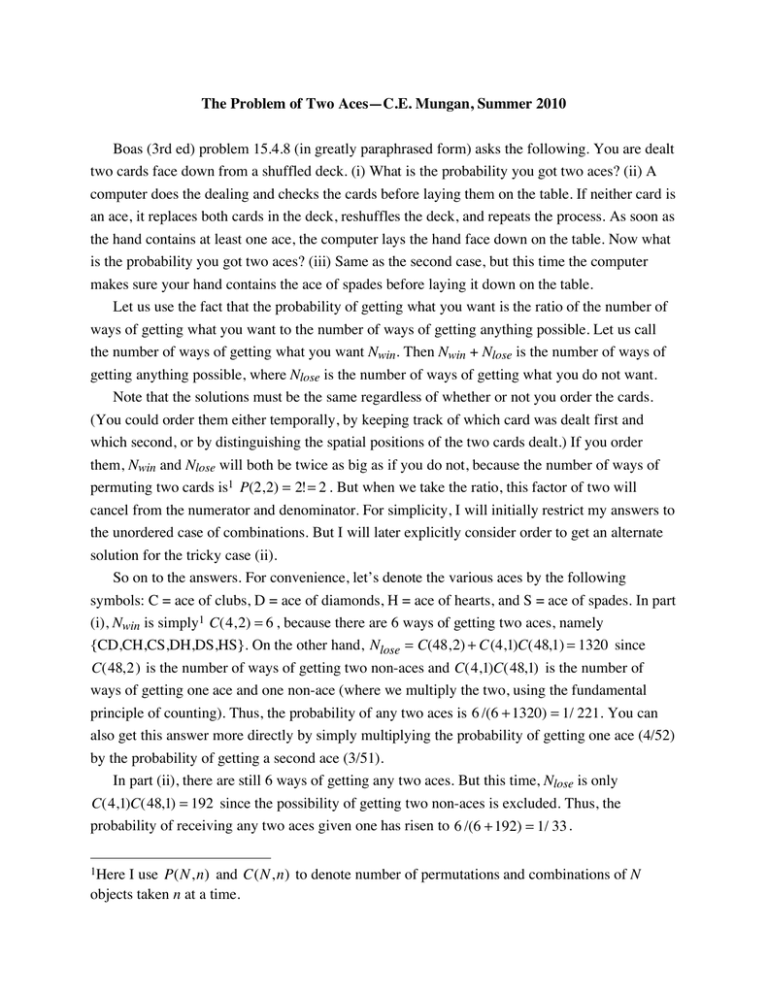The Problem of Two Aces—C.E. Mungan, Summer 2010
advertisement

The Problem of Two Aces—C.E. Mungan, Summer 2010
Boas (3rd ed) problem 15.4.8 (in greatly paraphrased form) asks the following. You are dealt
two cards face down from a shuffled deck. (i) What is the probability you got two aces? (ii) A
computer does the dealing and checks the cards before laying them on the table. If neither card is
an ace, it replaces both cards in the deck, reshuffles the deck, and repeats the process. As soon as
the hand contains at least one ace, the computer lays the hand face down on the table. Now what
is the probability you got two aces? (iii) Same as the second case, but this time the computer
makes sure your hand contains the ace of spades before laying it down on the table.
Let us use the fact that the probability of getting what you want is the ratio of the number of
ways of getting what you want to the number of ways of getting anything possible. Let us call
the number of ways of getting what you want Nwin. Then Nwin + Nlose is the number of ways of
getting anything possible, where Nlose is the number of ways of getting what you do not want.
Note that the solutions must be the same regardless of whether or not you order the cards.
(You could order them either temporally, by keeping track of which card was dealt first and
which second, or by distinguishing the spatial positions of the two cards dealt.) If you order
them, Nwin and Nlose will both be twice as big as if you do not, because the number of ways of
permuting two cards is1 P(2,2) = 2!= 2 . But when we take the ratio, this factor of two will
cancel from the numerator and denominator. For simplicity, I will initially restrict my answers to
the unordered case of combinations. But I will later explicitly consider order to get an alternate
solution for the tricky case (ii).
So on to the answers. For convenience, let’s denote the various aces by the following
symbols: C = ace of clubs, D = ace of diamonds, H = ace of hearts, and S = ace of spades. In part
(i), Nwin is simply1 C(4,2) = 6 , because there are 6 ways of getting two aces, namely
{CD,CH,CS,DH,DS,HS}. On the other hand, Nlose = C(48,2) + C(4,1)C(48,1) = 1320 since
C(48,2) is the number of ways of getting two non-aces and C(4,1)C(48,1) is the number of
ways of getting one ace and one non-ace (where we multiply the two, using the fundamental
principle of counting). Thus, the probability of any two aces is 6 /(6 + 1320) = 1/ 221. You can
also get this answer more directly by simply multiplying the probability of getting one ace (4/52)
by the probability of getting a second ace (3/51).
In part (ii), there are still 6 ways of getting any two aces. But this time, Nlose is only
C(4,1)C(48,1) = 192 since the possibility of getting two non-aces is excluded. Thus, the
probability of receiving any two aces given one has risen to 6 /(6 + 192) = 1/ 33 .
1Here
I use P(N, n) and C(N, n) to denote number of permutations and combinations of N
objects taken n at a time.
Finally, in part (iii), Nwin is simply C(3,1) = 3 , because if we already have the ace of spades,
there are only 3 ways of getting another ace, namely {CS,DS,HS}. By the same reasoning,
Nlose = C(48,1) = 48 since there are 48 ways of getting a non-ace instead. Thus, the probability
of two aces given the ace of spades is 3/(3 + 48) = 1/17 . Again, you can get this more simply by
noting that if you have an ace of spades, the probability of getting any other ace is 3/51.
Since many people find it difficult to believe the answer to part (ii), here is another way to
solve it, by this time distinguishing the order of the two cards. Consider two cards dealt from a
deck of 52. Distinguish the cards’ positions as L (left-hand card) and R (right-hand card). There
are 51 distinct hands having S in the L position, 51 with H in the L position, 51 with C, and 51
with D, for a total of 4 ! 51 = 204 allowable hands so far. Next consider how many additional
hands are possible with an ace in the R position. There are 51 possible ways to get S in the R
position, except that we must subtract 3 that have already been counted (namely HS, CS, and
DS), for a total of 48 new hands. Likewise, there are 48 previously uncounted hands with H, 48
with C, and 48 with D in the R position, for a total of 4 ! 48 = 192 additional legal hands. Thus,
there are a grand total of 396 ordered hands that contain at least one ace. Of these hands, exactly
12 have aces in both the L and R positions. The odds that both cards are aces, given that at least
one is an ace, is therefore 12 / 396 = 1 / 33 , the same solution as found before.
As one might have expected, the more information you have, the more your odds go up. If
you carefully examine the possibilities, you will realize that there are twice as many ways to get
any two aces as to get the ace of spades plus any other ace. But there are four times as many
ways to get any ace plus any non-ace as to get the ace of spades plus any non-ace. Thus, your
odds roughly get halved if you only know you have an ace but don’t know its suit.
Thanks to Eric Nelson and Ann Reagan for some of these ideas. John Mallinckrodt tested
these solutions by writing a program that deals hands according to these rules and counts the
fraction of hands that contain two aces. John Denker emphasized that the dealing must be
neutral—for example, it must be clear in case (ii) how the hands were prepared so that it is
known they contain at least one ace. The solution to that case would be different (as emphasized
by John Mourning) if the computer first separated out the aces, drew one out at random, then
replaced the remaining 3 aces in the deck, reshuffled, and drew a second card out of the deck and
dealt you those two drawn cards. Finally Philip Keller suggested comparing this problem to the
following puzzle. “The Greens have two kids: what is the probability that they are both boys?
The Whites have two kids, at least one of which is a boy: what is the probability that they are
both boys? The Browns have two kids, the older one of which is a boy: what is the probability
that they are both boys?” The answers are again different in all 3 cases (1/4, 1/3, and 1/2
respectively).






